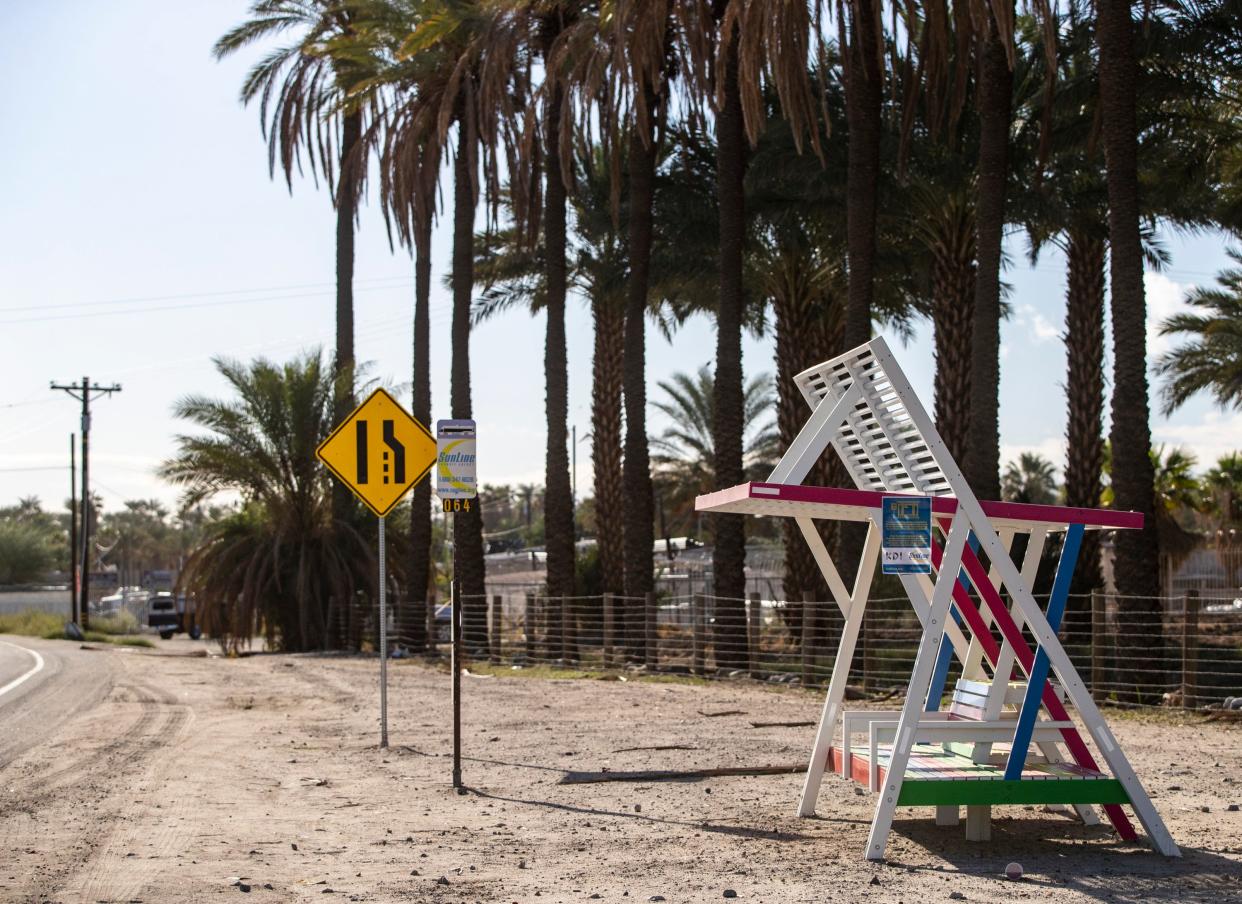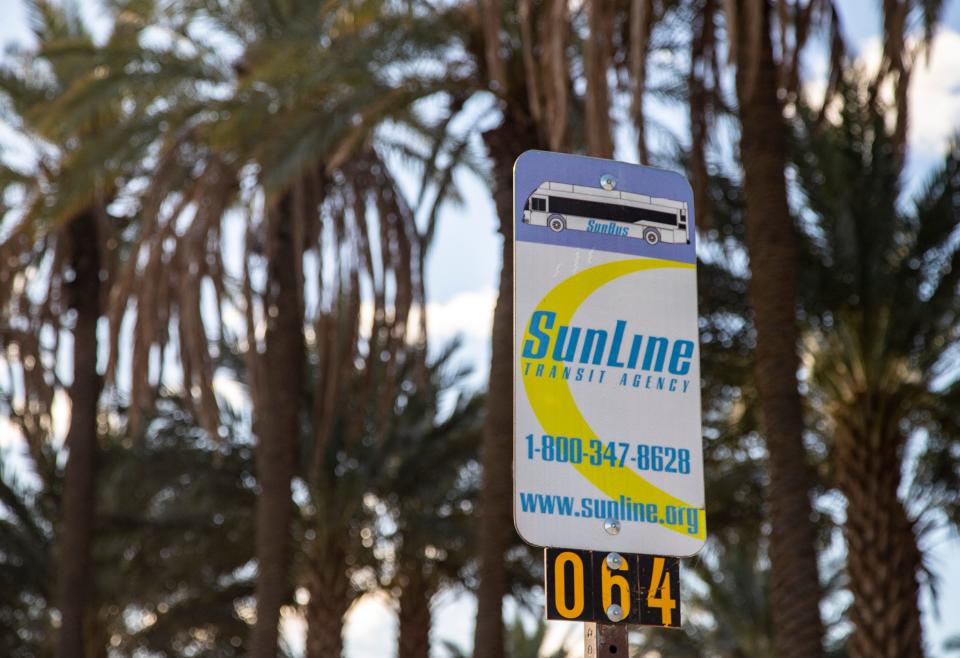Why aren't there more bus shelters in unincorporated eastern Coachella Valley?

For the past month, riders boarding SunLine’s buses at the intersection of Avenue 66 and Harrison Street in Oasis were greeted with a colorful sight: a rainbow-painted bus shelter providing seating and shade.
The bus shelter prototype was part of a month-long demonstration project created through a partnership with Kounkuey Design Initiative, SunLine and the Oasis Leadership Committee.
"We were looking at our bus stops in Oasis, and sometimes it's just a stick in the woods. And we don't have many people using the buses so we thought, what if there was actually shade, and a place to sit, and it was safe from the heat?" said Limba Contreras, president of the Oasis Leadership Committee, a group of community members established by KDI.
KDI is a community development and design nonprofit that has worked on projects in the eastern Coachella Valley for over a decade.
KDI, the Oasis Leadership Committee, and the Luskin Center for Innovation at the University of California Los Angeles have also spent the past two years developing a study focused on how drastic heat changes are affecting Oasis residents.
The recent shade structure demonstration came out of that study, which found that shade is scarce in Oasis. V. Kelly Turner, co-director of the UCLA Luskin Center, says Oasis is essentially a "giant shade desert" — while some communities have pockets of shade deserts and other shade oases, Oasis has very little available shade due to a lack of taller buildings or trees, outside of those used in an agricultural setting.
"Shade simply is the most effective way to cool people when they're outside. There's no other kind of passive cooling technique that can do as much for a person and their thermal comfort as shade," Turner said. "Every city needs to be planning for shade and probably planning for more of it, given what we're anticipating with climate change."
The Oasis shade structure was set to be removed in early November, and like many other bus stops in unincorporated communities in the eastern Coachella Valley, the Avenue 66 and Harrison stop will again be marked only by a SunLine sign in a dirt shoulder along the side of the road.
The shade structure can’t stay permanently because of ADA requirements, according to SunLine, which dictates that the bus stop would require a sidewalk before adding a bus stop structure, among several other accessibility requirements.
Sidewalks themselves are driven by development, according to Mark Lancaster, director of Riverside County's transportation department. Some county roads in more rural areas like Oasis were built without sidewalks, and as landowners develop property in the area, the county "will condition that developer to widen the roadway, build sidewalks, curbs, gutters, and maybe other amenities as part of their project," he said.
Oasis has one of the lowest percentages of bus stops with shade structures in the Coachella Valley — just two of the community’s 10 bus stops, or 20%, have bus shelters. In unincorporated Riverside County overall, 39% of bus stops have shelters, and across SunLine’s service area, 372 of 577 bus stops, or 64%, have shelters.
Christian Rodriguez, a Coachella-based community associate with KDI, says the lack of bus shelters is tied to the overall need for improved planning and infrastructure in the area's unincorporated communities.
"There's some real questions about infrastructure investment and where it's being prioritized, and another question on the influence of developers and development, and how unfortunately a lot of times that's the power behind these types of interventions. And I'm hoping that we're not going to have to wait years down the line when we start seeing more investment coming in, but that some of this can be done now and with the community's vision for the place," said Rodriguez.
Indian Wells, Cathedral City and Palm Desert have among the highest percentages of shelters at bus stops, all over 80%. In unincorporated Thousand Palms, all of the community's nine bus stops have shelters.
According to SunLine, a variety of factors contribute to which bus stops get shade and which don’t. In addition to adhering to accessibility requirements under the ADA, SunLine does not own the locations of its stops, and must get a permit from the municipality to occupy space in that community’s right-of-way along the road.
“We have no control over how cities make infrastructure decisions or where they place sidewalks. We do, however, work closely with city planning staff to advise of our transit amenity needs to help them make investments that benefit the community,” wrote SunLine spokesperson Andrea Carter in an email to The Desert Sun.
"It's sort of the chicken and the egg. We can't have a permanent shade structure for this bus stop, because there's no sidewalk, but there's no sidewalk because there's no investment," said Rodriguez.
Each one of SunLine’s 205 stops without shelters “may have a different set of obstacles,” according to Carter. The footprint size of the stop could prohibit the installation of a bus shelter, for example. Other factors include ridership at that station, feasibility, and funding — each improved bus stop with a shelter costs anywhere from $18,000 to over $250,000, according to Carter.
Currently, SunLine policy states that bus stops with more than 10 boardings per day warrant a shelter. Under this threshold, there are only 29 stations that currently receive that number of passengers but don’t have a shelter. Those are located in Coachella, Desert Hot Springs, Indian Wells, Indio, La Quinta, Palm Desert, Palm Springs and Desert Edge. SunLine plans to install those 29 shelters over the next three years, according to the agency’s 2023-2025 short-range transit plan.
This policy doesn’t mean that only stops with more than 10 daily boardings get shelters, as only 222 SunLine stops have more than 10 boardings, while 372 have bus shelters.
Oasis’s one station with more than 10 boardings per day does have a bus shelter, and in other east valley unincorporated communities, the stops with more than 10 daily boardings also all have shelters. Out of the 41 bus stops in Thermal, Oasis, Mecca, and One Hundred Palms, seven stops have more than 10 daily boardings and 16 stops have shelters.
According to Rodriguez, shade structures themselves could also boost transit ridership, as KDI heard during community outreach that a lack of shade is one reason why some people don’t take the bus.
SunLine is working on ways to expand shade structures within ADA requirements and other hurdles through efforts like the pilot structure in Oasis, according to Carter.
Rodriguez says KDI hopes to add more heat interventions in Oasis over the next two years.
"This is a pilot that's meant to create a conversation, and give the community the opportunity to see a reality that's addressing the problem, and an opportunity for SunLine to start thinking of ways to address this," said Rodriguez.

Shade crucial for extreme heat
The additional shade in Oasis is much-needed, especially with already hot temperatures in the valley rising due to climate change. Climate change is expected to push daily average high temperatures up by 8 to 14 degrees by the end of the century, exacerbating existing heat impacts that disproportionately impact low-income communities and communities of color.
Last summer, UCLA researchers and community members recorded temperatures both inside homes in Oasis and outside around the community to start building a profile of how heat affects community members throughout the day, both at home and while out at work or running errands.
"A person's heat exposure is cumulative throughout the day. So a resident of Oasis is going to go from a home that's potentially quite hot, then go to public transportation which is also quite hot and exposed in the sun, the children will go to school... where the outdoor spaces are quite hot, and the parents are going to go to work in the agricultural fields, which are exceptionally hot," said Turner. "That cumulative heat burden that a person is feeling is going to be what's ultimately dangerous."
Turner said efforts like adding shade structures can help address that heat burden because people aren't always able to drop their daily lives to find a cooling center or go somewhere that's air conditioned.
In Oasis's mobile homes without air conditioning, the temperature inside was hotter than the peak temperature outside — and throughout the day and overnight, temperatures remained above 80 degrees. In nearby Palm Springs, the city code requires that rental units include air conditioning capable of maintaining a maximum temperature of 80 degrees. While that code wouldn't apply to mobile homes, Turner says it still points to the difference in heat impacts between Oasis and nearby Palm Springs.
"It's one thing to be sun-exposed all day long, and go to a well-insulated, single-family home with air conditioning. And it's quite another proposition to have that same daily experience, and go to a home that's hot and not be able to get your core temperature down to a safe level," Turner said.
Erin Rode covers the environment for the Desert Sun. Reach her at erin.rode@desertsun.com or on Twitter at @RodeErin.
This article originally appeared on Palm Springs Desert Sun: Pilot project showcases a possible solution for 'shade desert' in Oasis

